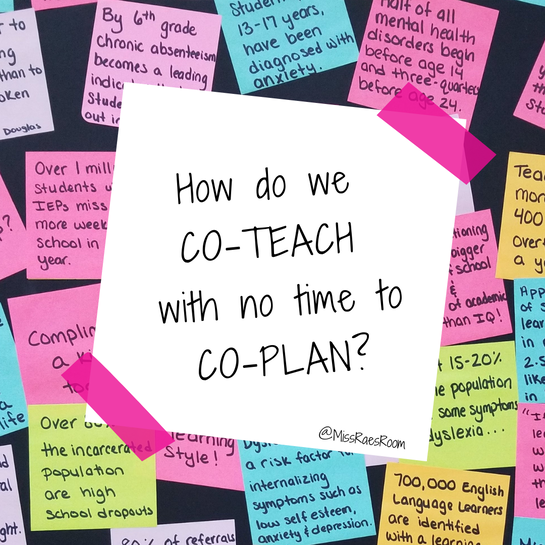|
The benefits of co-teaching cannot be denied, from extra student support to targeted small groups to someone to handle the band-aid and phone call interruptions, and finally, someone to get your sarcasm and cover an adult bathroom break!
Research studies on co-teaching between a general education teacher and a Special Education teacher results in additional individualized attention for students, more on-task student behavior, and more interaction with teachers (Murawski, 2006; Zigmond et al., 2003). But how do we co-teach when there is no time to co-plan? 1: Divide and Conquer Establish a skill role and a strategy role. The general education teacher, the expert of the content, teaches the skill/concept. The goal of Special Education is to assist students with disabilities in access the general education curriculum. The Special Education teacher, then, takes on the role of the strategist. After the skill/concept is taught, the strategist teaches a strategy to apply the skill in order to access the concept. For example, the co-teachers plan to teach Author's Purpose. The general education may do a mini-lesson on demonstrating different text and media for different purposes. Then, the Special Education teacher teaches the strategy of PIE, a strategy for identifying the purpose of a text (PIE = persuade, inform, entertain). 2: Share Student Data IEPs contain a TON of information, and all of that information is very important. Special Education teachers can help to make IEPs easily accessible for general education teachers by created IEPs at a Glance for each Special Education student in the classroom. An IEP at a Glance is typically a one page abbreviated document of a student's IEP. They can help to ensure that general education teachers, classroom paraprofessionals and other related service providers are aware of and consistent with working on IEP goals, modifying and adapting curricula, and providing behavioral support. Ultimately, it gives all staff a quick reference to a student's IEP.
3: Common Lesson Plan Template
Create a lesson plan template at the start of the school year together. Each teacher can fill in his/her role or part of the lesson plan. Keep a section for notes or post-its next to the plan. Comments can be added to the document in a notes section (i.e. When are we planning to have this test? Don’t forget about the assembly on Friday! Adam refused to complete his DO NOW again). Keep a package of post-it notes next to the lesson plan for these comments and questions! Add a blank page each week that is dated daily to write notes about students. Write down those things that if you don’t share them immediately, you will forget (i.e. anecdotals that were observed or shared, a heads up that mom gave in a phone call, etc.). This eliminates inquiring minds (the listening ears of our students), no time for consulting, and time off task!
4: Google Drive
Google Drive is a teacher’s best friend in the classroom! How great is it to not have to carry piles of paper home to correct?! Teachers can list hundreds of ways that Google Drive has added a benefit to their instruction and student learning! So why are we not using it for other roles in the classroom? Re-read tip #3 and apply it to Google Drive! :) And lastly, some words of wisdom… Have an open mind, be willing to compromise, and be a team! And remember, above all - we are here for the students! ~By Miss Rae
References:
Murawski, W. (2006). Student outcomes in co-taught secondary English classes: How can we improve? Reading & Writing Quarterly, 22, 227–247. Zigmond, N. (2003). Where should students with disabilities receive special education services? Is one place better than another? The Journal of Special Education, 37(3), 193- 1999.
0 Comments
Leave a Reply. |
CategoriesAll Comprehension CoPlanning CoTeaching Directed Reading DIY Fluency Fountas & Pinnell Graphic Organizers Guided Reading Lesson Planning Multi-Tiered Systems Of Support Phonological Awareness RAN Read And Respond Reading Reading Comprehension Response To Intervention RTI Science Of Reading Science Of Reading For Special Education Teachers Special Education Eligibility Special Education Lesson Planning Teaching Strategy Visualizing & Verbalizing Visual Texts Vocabulary Writing Writing In Response To Reading |





 RSS Feed
RSS Feed